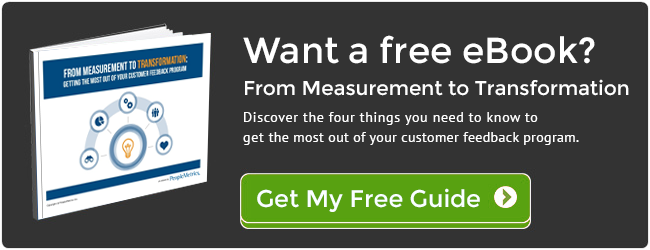In customer experience management, we use transactional surveys to guide actions for customer centricity. So for example, after you stay at a hotel, you might take a survey about your stay. If you note that the mattress was “lumpy,” and the man at the front desk “dumpy,” then the hotel can take appropriate actions to address your rhyming complaints.
Such exchanges are typically what prospective clients seek from customer experience software like ours. They want those exchanges to reveal individual and systemic issues.
But we’ve noticed a trend of companies asking us for transactional surveys before they truly understand their customers. Which is putting the proverbial cart before the horse. Or the icing before the cake. Or the in-depth morning sit-down before I’ve had my 14 cups of coffee.
So let’s take a look at why it's important to develop customer understanding before you jump into transactional customer surveys.
1. Understanding helps you segment and prioritize your customer types.
Customer understanding helps clarify what you’re trying to accomplish, and for whom. By dividing customers into clear segments at the onset of your strategy, you can better prioritize your efforts.
The fact is, your business can’t be everything for every customer. Variables like time, bandwidth, and budget will limit where you can focus, where you can have the most impact, and what’s worth the effort.
However, if you know your customer segments and what drives each of them, you can prioritize how you invest time, energy, and money. You can target the elements of your experience that matter most to your customers.
Here are some questions to help you get started in segmenting your customers:
- Who can we delight the most, for the best return?
- What’s the lifetime value of each customer type?
- How can we effectively support customers at different price points?
- What are the goals of each of our customer segments?
- What do they want most, and what can they live without?

2. Customer understanding helps you design experiences that work on an emotional level.
A customer’s emotional experience drives their perception of any business. To manage (as much as we can, anyway) the emotional journey of our customers, we have to empathize where customers are coming from and what they’re after.
That sort of empathy should begin before you dive deep into transactional customer surveys. With a firm understanding of what each customer segment wants, what drives them, and the way they interact with your company, you can design experiences to appeal to them. You can get beyond the functional aspects of your customer experience, and focus on the emotional connections that build engagement and loyalty.
Here are some questions to get you started in emotional understanding:
- What’s each customer segment’s biggest frustration?
- What can we do to make their lives a little better?
- If we could generate one major emotional response per customer segment, what would it be?

3. Customer understanding gives you a competitive advantage.
Customer understanding should be a key element of your early CX strategy. It can generate and refine priorities and provide a better sense of the emotional connection you want to create with your customer experience.
It can also give you a distinct advantage over your competitors.
If you can create a strong, focused customer experience strategy early, you’ll be able to make the most of customer or client satisfaction surveys. It will create frameworks and contexts to help you make sense of feedback and act on it effectively to drive business results. Consider these questions to help you frame your competitive edge:
- Why would our customers trust us over a competitor?
- What parts of our experience can we bolster to differentiate against our competitors?
- What are high-impact needs of our customer segments that our competitors don’t satisfy?
Your customer experience strategy shouldn’t be a snatch-and-grab race for every available customer. Instead, imagine it as a garden. Focus on identifying the customers that will flourish, and offer care and nourishment to help them succeed. In such an environment, customer feedback can help reveal where upkeep is needed, and where new opportunities lie.
If you concentrate on the customers that work best for your business, you can help your business work for them. And after all, isn't that what you want from your customer experience strategy?

Want More?
Learn more about customer experience strategies by checking out our blog, or subscribe using the widget at the top right of this page to get notified of new posts as they're published. For more about how PeopleMetrics helps customer understanding before transactional work, you can also check out our Voice of the Customer solution or click on the button below.





%20(1).png)